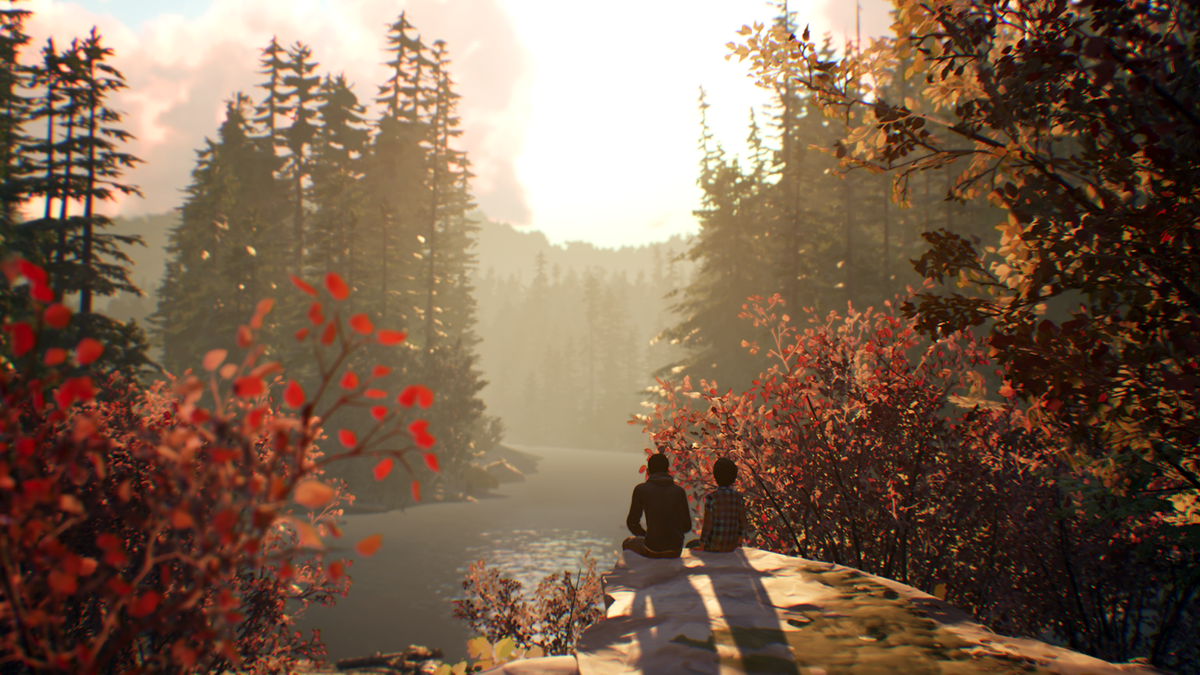
It was a beautiful but humid day in the middle of San Diego Comic-Con when we sat down with Raoul Barbet, Co-Creative Director, and Jean-Luc Cano, Lead Writer for Life is Strange 2. The pair flew in all the way from France to chat about the upcoming fourth episode, and their work within the expanding Life is Strange universe as a whole.
Raoul Barbet: Just to introduce ourselves, Jean-Luc is the writer of Life is Strange 1, Captain Spirit, and Life is Strange 2. And I’m one of the two Creative Directors with Michel [Koch] who is not here, and we work together on the story, and he writes the game. So–you have played until the most recent episode, or..?
Gaming Trend: I haven’t gotten to play the most recent episode, but I’m current up until then. I’m a big fan of the series–what I find most interesting about Life is Strange 2 is that this time, you’re not actually in control of the character with the gimmick. This time around, your brother is the one with powers, not your character. What was the thought behind that shift?
Raoul: I think at beginning us three together, with Michel, we asked ourselves which project we want to create, and also discussing with Square Enix about the brand… What is Life is Strange? And very quickly we wanted to change completely the type… not the type of game, but the type of the story, I think. So very quickly went to a run movie… like a run movie-film structure.
We wanted to talk about the theme of education; that’s how we came up with the character of Daniel. How is it to take care of someone else? And the important aspect of the supernatural elements that we wanted to tie into the game that why also we give it to Daniel, to not having the player directly involved with it, like we do with Max in the first episode. Like we wanted a mechanic very linked to the to the character herself, and to the fact that it’s difficult for her to grow up, so it’s linked. It’s the same, in that we wanted to link the power to Daniel, to show that if you are in charge of someone, you could have terrible consequences. So I think it was the beginning of… it was a lot of discussion of course, but we finished with a story in the end. So, education, road trip, and putting the players with this younger brother in difficult situations.
GT: Life is Strange has always seemed, to me, to really be about relationships. Did this feel like a natural progression to you, or did you see this as a radical change to the game?
Jean-Luc Cano: I think as Raoul said, for the new game we wanted to challenge ourselves, to change the character, to change the pacing of the game, to change the structure, because we want to tackle a new subject. We really want to give the player a new experience. So yeah, we also want to change the kind of relationship you can have in the game. In the first season it’s really about friendship between Max and Chloe, and, as a player, how you want to make this relationship evolve.
In Life is Strange 2, the main theme is education, so we wanted the player to explore the fact that every choice he is going to make–every dialogue he is going to choose will have a consequence on him, but also on someone else. And the someone else, Daniel, will be shaped regarding, according to what you are going to do. It’s not really an evolution, it’s another thing, maybe for next–we don’t want to do the same thing again and again, and, yeah, maybe it’s a real [goal] that we have to change ourselves and, yeah, explore new territories.
GT: I remember after Life is Strange: Before the Storm came out, some fans felt like the time mechanic was core to the Life is Strange experience. What has been your experience with fans, do you feel like they have adapted to the changes you’re making with the gameplay mechanics?
Raoul: It’s something that’s a bit scary at the beginning–maybe scary is too strong, but we were wondering if… Of course players will miss Max and Chloe, we knew some players will miss the power from there, but of course the power was really linked to the story we wanted to tell, it was… natural for us to change, and to have a new power. So, I think Life is Strange is not about the rewind power, it’s not about Max and Chloe, it’s more than that, I hope. It’s about telling the story of believable characters and being able to talk about important themes for us, or for problems for societies. So I think, at the beginning, some players were a bit disappointed, and maybe there are some who are still disappointed, but the more they play this episode they understand what we want to create, so ok, it’s another mechanic. It’s other characters, but it’s… we hope it’s still the same DNA.
I think a lot of players even know the prequel from the first episode, it has other themes than Episode 2. It’s a bit darker, sometimes more adult, but it shows the way the characters are evolving. So I’m happy, but I’m always sad when players are disappointed without Max and Chloe, but it’s a new game.
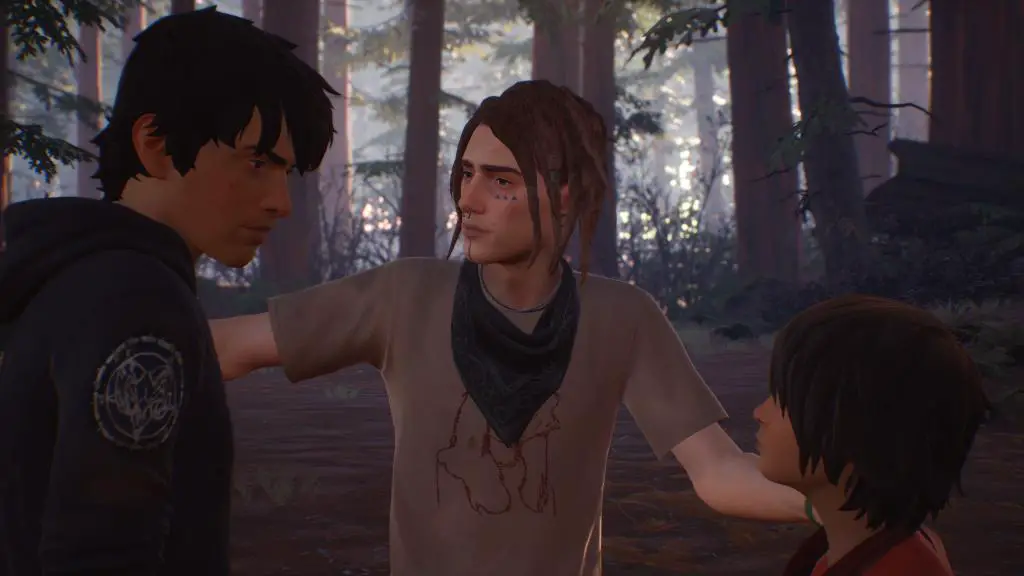
GT: I really do appreciate each character’s power is very tied in to their personality. How do you go about that process? Do the characters come first or do the powers come first, or are they developed in tandem?
Raoul: You made a good point because, you know, the first Life is Strange, as you said, the power is linked to the weakness of the main character. In the first season, the weakness of Max is that she was afraid of growing up; the whole game is about this. And that’s why the power of rewinding time was linked to her, because if you’re afraid to grow up, you are afraid to take decisions, and so you can rewind time and choose another path. In Life is Strange 2 the theme is education, so we think it was important to give the power not to you, but to someone you are going to shape. If you are going to take good–moral–I don’t want to good–but moral decisions to the end, he will use his power in a moral way. If you are making unmoral (sic) or evil decisions, for good, but sometimes you can still make mistakes–they will evolve in another way. And yeah, the power is always linked to the main character’s weakness. So that’s something that was really important for us.
To answer the real question, I think for this one–for the first Life is Strange, the power came first. We had to use the rewind mechanic we created for Remember Me into a new game, but for Life is Strange 2 I think the story came first, we had the idea–
Jean-Luc: At the same time, I think. We had a list of powers, of supernatural elements, and we very quickly, as the story was written, we knew which kind of power we wanted to have. It evolved a bit, but it came at the same time, I think.
GT: One thing that’s so unique about this game is that they don’t include your usual branching storyline idea of a good, a bad, and a neutral ending. How do you tell a story like that, with so many shades of gray, when you aren’t controlling the character who has the powers, and not fall into the tropes of good and bad endings?
Raoul: I think… In the first season, you have two endings, you know, and there is no good or bad ending; it’s only about your choices as a player. And we have always said there is no ‘canon’ ending to Life is Strange. The two endings are canon and we are not here to judge what is good or what is bad. If you’re happy with your choices that’s fine. And it will be the same for Life is Strange 2; there is no good or bad that will–I won’t spoil the end, of course. But it’s important to keep that in mind; it’s not about telling the player, giving a lesson, a life lesson. “That is a bad choice, don’t do that, do this.” No, it’s not about this. It’s about make your own decision because… what we like to do with Michel is to make a game that makes you think about who you are. And you know who you are, not by saying I am this kind of person, it’s by making choices. That’s why our game is only about making choices; moral choices. At the end of the game, what we really want to do, is when the player puts his controller [down], “Okay, I played a game, and I learned some stuff about me.” And that’s why, that’s how we build the game.
Jean-Luc: And on a design point of you, I think for each choice, it’s important to have a good context for the choice, and to be sure that the player has enough context and understands maybe the short term consequences, so he can chose knowing those, but be surprised after by the long-term consequences. So it’s how we worked on Life is Strange 1, it was more difficult because there’s a rewind, but here it was the same. For Life is Strange 2 it’s to find some moments that choices are interesting. There’s maybe less choices than in the first Life is Strange, less main choices, but the idea is that every small action could have some consequences on your brother. So it’s quite different, but it’s the same that you have to go on and live with your consequences of your choice.
GT: Do you have a favorite Life is Strange character?
Raoul: I would say Chris. I think… I really love the Awesome Adventures of Captain Spirit, and I really love this project. As it was smaller, even if it was it was still difficult to create. It was smaller so you really have to create a story and characters that talks very quickly, so in less than one hour, and yeah, I love that he’s going to get to his universe, his imaginary world, and yeah. I would say Chris… today. Tomorrow that may change.
Jean-Luc: Yeah so he is good, but really, I’m a huge fan of Max. I really really love her. And in Life is Strange 2, I really like Cassidy. In Episode 3, I really love this character.
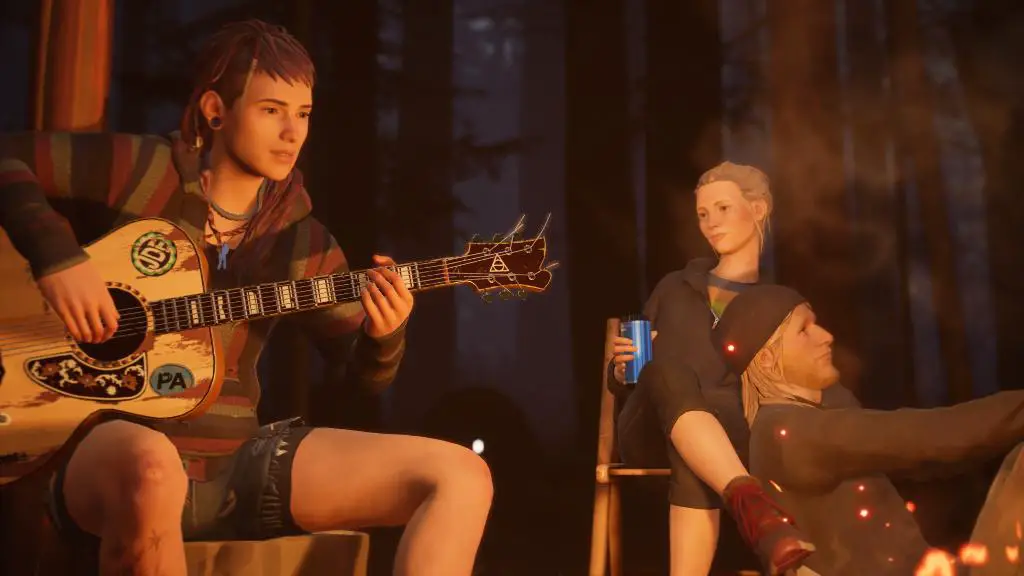
GT: I really can’t wait to play Episode 3 now!
Jean-Luc: You have to!
Raoul: Yeah, there are a lot of things… players love Episode 2 because it reminds them some of the aspects of the first season.
GT: How did you choose education to be the major theme of this episode? Do you spend time mentoring, do you have children, what inspired you tell a story around this particular theme?
Jean-Luc: You know, the first Life is Strange was a coming-of-age story, and when I was writing the first Life is Strange, with Michel and Raoul, I’d just become a father. And yeah, when we were working on the very beginning of Life is Strange 2, I’d just figured out that, in my life, everything I was doing or saying my daughter would take it as an example. So I’d say, “Don’t say bad words, you don’t have to curse, it’s bad.” “Yeah… but when you’re driving, you say a lot of bad words!” “…Okay, yes, but…” So you have to explain everything. And I thought that okay… it could be a good gameplay, a good theme to explore, when everything you are doing, when everything you are saying, someone is taking it for an example, so they will be shaped by your own action. It’s a massive pressure on your shoulder. So when you put it into a game… and that’s what we want to do with Life is Strange 2, and I think it’s great. You have the responsibility of something. And I think it’s the thing I’m most proud of in Life is Strange 2 is that the players take care of Daniel. And I really like to see that the people are good with him. That’s very cool.
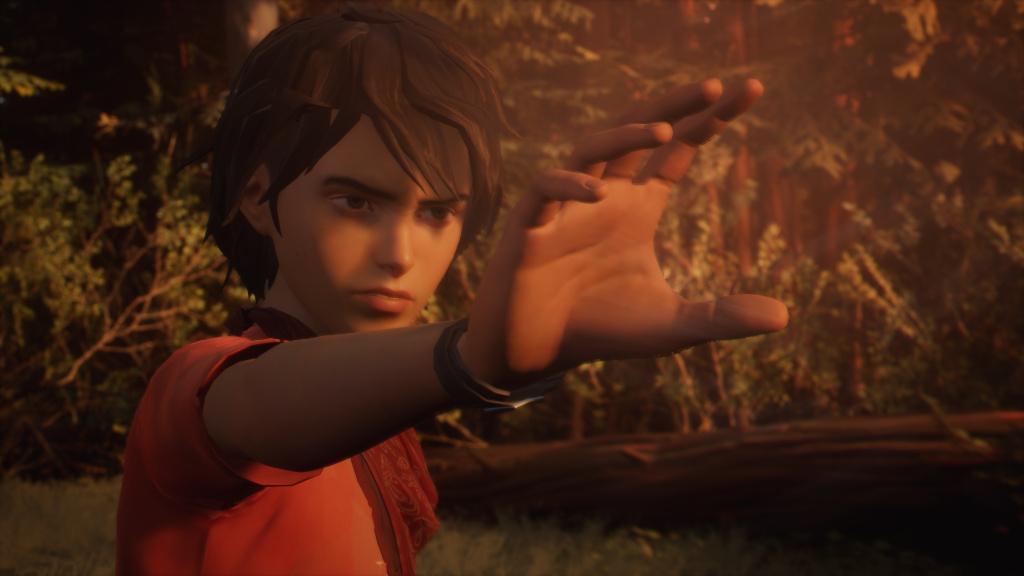
GT: I really find this to be an interesting twist, because games are usually about you, the player. Your character, your choices, and in Life is Strange 2, you do take the actions, but those are really only influencing the character who actually has powers. That’s such a different approach to a game.
Jean-Luc: Yeah, we are really happy with it, but you know, on the writing way, in the first episode, Daniel is basically the same. But more and more episodes are going on, Daniel is more and more shaped by your decisions. So you will have different Daniels depending on the player. So yeah… I will let you discover it, but you can have different possibilities and different personalities of Daniel.
GT: The music in the first game was so iconic, and everyone was really into the music. How did you approach a soundtrack for this one?
Raoul: For the music, so I have hired Jonathan Morali from Syd Matters for the first Life is Strange, a composer for the score. And since the beginning, we wanted to have a mix between the original score and these tracks. For Life is Strange 2, we wanted to continue, but having… we have less licensed tracks on this one, but we have much more score. I really love the works of Jonathan and I wanted to have more score because of the story, the fact that the brothers are evolving, and the people they meet are evolving, so we have different themes for each episode. We have at least, I think, two or three themes for each episode, composed especially for the game, so we total those to have much more original score from Jonathan.
For example, in Captain Spirit we had three licensed tracks, so there is one from Sufjan Stevens that is more of the Life is Strange vibe, I would say, like indie-folk vibe, from an incredible composer, and the last song is a song from Rone, that is a French artist, and so we wanted to transition between the classic folk vibe of Life is Strange 1, and the more… not electronic, but with new songs, the new… feeling, when you hear it, of Life is Strange 2. And if you listen to the score of Life is Strange 2, it is quite different from the first season, and following the same idea. For example, at the start of Life is Strange 2, we have this really indie-folk vibe during the Seattle scene. Then, after the death of the father, we break that to have something different and more… with some electronic sound extra, also. So we discussed a lot with Jonathan, and I worked with him and the team to make the score evolve a bit. And you will see that the score is still evolving in Episode 4.
For the licensed tracks, it is the same process as in the first one; I will choose some songs and we try to add the rights and work on them. And you will see in Episode 3 when you play it, I am really happy with the licensed tracks we have in Episode 3. It is really different from the one we have usually in Life is Strange, so I’m really happy.
GT: You mentioned earlier about how important it is you that players put down the controller having learned something about themselves; how big a factor was the ethnicity of the boys in Life is Strange 2, given the current political climate in America?
Raoul: The DNA of Life is Strange is to deal with social themes, and to talk about our world, because LIfe is Strange is really a contemporary… present stories. What we don’t want is to make a statement, we as the creators of Life is Strange; “We are thinking that this is good or this is bad.” We only want to put the player in front of a subject, in front of scenes, in front of themes, and make him think about it and make his own opinion. Sometimes, you know, you have people who are thinking about racism and stuff like this, but they haven’t experienced it on their own. By playing Sean and Daniel, maybe they will change their mind, and think “Okay, I didn’t know it was existing.” In the first Life is Strange, we talk about abortion, talk about euthanasia, and stuff like this, and we don’t say this is good or this is bad, but we wanted to provoke discussion. Make people think about stuff and maybe change their mind–or not–but I think it’s part of what we’d like to do, is to… not to give statements, but to make people think about the world they are in. So that’s why, in Life is Strange 2, we talk about violence, about racism. New themes that we couldn’t talk about in the first season we explore in the second one.
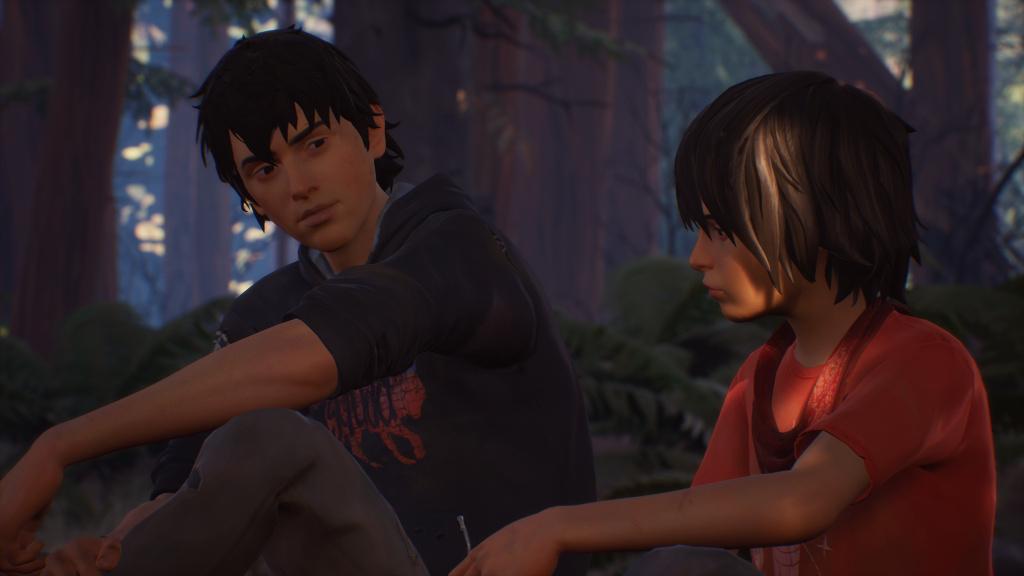
GT: Is there anything you’d like to say to fans who are gearing up for Episode 4?
Jean-Luc: Yeah, get ready for the 4th, for sure!
Raoul: I hope that you continue to take care of Daniel and love him, and yeah. We… always happy to see… again on Episode 3 we got tremendous feedback on Episode 3. Episode 4 will be really, really different, so I hope you won’t be disappointed, but the idea is also because it’s a road trip format is to change from one episode to another to really explore new themes, new environments, and so I hope they will like it.
Jean-Luc: We have a lot of surprises!
GT: Do you have a favorite story about fans opening up to you about how Life is Strange has changed them or impacted their lives?
Raoul: Oh yeah, for sure. We’ve had a lot of things like this. With this one… especially about people having younger brother or sisters, and they just open up a lot about that. And of course for the first seasons, all the pressure you can have as a teenager. And yeah, a lot of people explain to us that it helps them. And also to be better, as Jean-Luc said, to discuss with their family and with friends about some subjects. Because they have seen it in the game they can now talk about it, I think it’s incredible to read this and see that. That’s why we’re creating games.
Thank you to Raoul Barbet Jean-Luc Cano for taking the time to chat with us about the world of Life is Strange. Life is Strange 2 Episode 4 will be coming to Xbox One, PlayStation 4, and PC on August 22nd. Check out our review of Life is Strange 2 Episode 1, and head on over to the Steam Store to learn more about the newest chapter of Sean and David’s adventure.